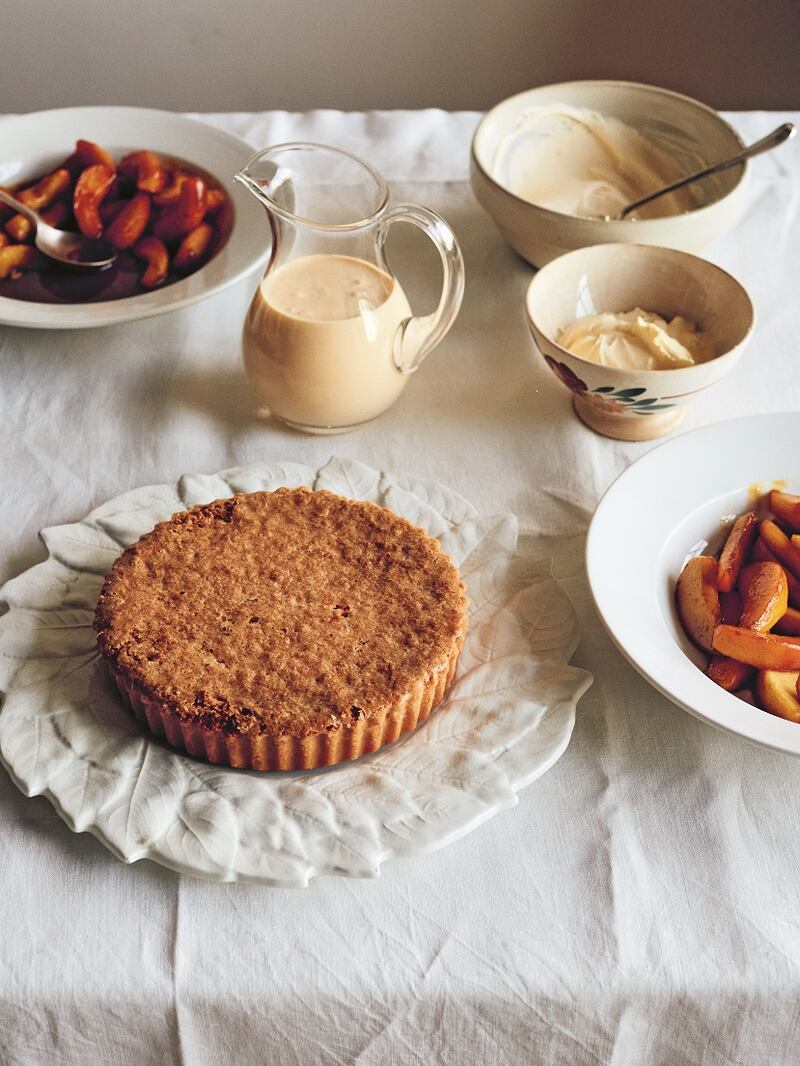It’s not every cookbook that finds its central motif in a TS Elliot poem. But you’d never expect Jeremy Lee to write just another cookbook, would you?
Lee, chef proprietor of Quo Vadis restaurant in London, has written a book simply titled Cooking, that is at once a tribute to the joys of the home kitchen and a beautifully written throwback to the golden days of cookbooks.
Having worked for traditionalists such as Simon Hopkinson, Alistair Little and Terence Conran, Lee is a great proponent of the beauty of simple things done well. Hence the quote from Elliot: “We shall not cease from exploration/And the end of all our exploring/Will be to arrive where we started/And know the place for the first time.”
You have been cooking professionally all your life. Why did you decide to write this particular book, and why now?
READ MORE
I think this book was gestating for a long time. The idea had been around for a while, but the stars never aligned, the muse never sang. In a way, Covid was actually a blessing. Having worked as a restaurant chef for so long, having the opportunity — no, the necessity — to cook at home gave me the spine I needed for the book. I was reminded that sometimes going into the kitchen and chopping things is itself a joy. And thankfully I had an incredible crew of folks around me doing wonderful things to make it happen.
When you started thinking about this book, who were the authors that inspired the way you wanted to write it?
I wanted the book to have that arbitrary touch that Jane Grigson’s Good Things is so notable for. That and Julia Child’s The Way to Cook were very much in my mind. I really like the freeform of Grigson’s recipes and notes and Child’s forthrightness.
Recipes in most cookbooks are written almost like prescriptions. Yours are more like poems.
That’s very much how I’ve always written. I think the thing I’ve always loved about the books I adore is thinking ‘Oh god, I really want to make that,’ and then reading the recipe and thinking ‘Oh god, I think I can make that.’ Then you get into the kitchen and tuck in.
I want to encourage someone that they can go into the kitchen and not be punished with an arduous process, but think they can go in and in half an hour make something absolutely delicious— scrambled eggs on toast, even better if you have anchovies and capers.
It also came very naturally because somehow I was so fortunate to dodge the ferocious bullet of working in restaurants where you were constantly pummelled. I somehow always worked in kitchens where we were encouraged to read cookbooks and we read them like thrillers. So much of that lodged in my subconscious like that. I want to be somehow charmed by a recipe.
Most cookbooks are organised to proceed menu-fashion. This book is more of a patchwork quilt. Rather than ending with desserts, the last chapter is on wild garlic.
It was always going to be a big scrapbook of things I love. It was always going to be much more about cooking at home rather than in a restaurant, which really is a realm that’s nearly impossible to achieve at home, unless you’re cooking on a mass scale. I quite like having a foot in each camp and that I can dance between the two of them quite happily. Sometimes it’s even hard for me to distinguish which is which, and I think that is quite lovely.
It seems that so many chefs are looking to invent new ways of doing things. Every recipe in this book feels like something we have been — or should have been — cooking all along.
That’s why the TS Elliot poem seemed very lovely and very appropriate to include. Cooks being naturally curious creatures, we’re always excited to explore and to try different things. But what is really interesting to me is when after you’ve done that, when you do come home again and see those old familiar things again, you are reminded of how lovely they are.
The best thing about going away is coming home again and appreciating it anew. The dishes feel very familiar but maybe made more interesting. They’re familiar, yet far from humdrum. They’ve been reawakened and quickened and reimagined in some respects, but very simply.
Jeremy Lee’s almond tart

An almond tart is a testament to faites simple – a recipe requiring simple ingredients of superb quality. In this case, almonds, eggs, butter and sugar mixed with care. Over the years I’ve tasted, and made, many almond tarts but the best were made by Mum. She scoured books galore for different pastries, some plain, all made with butter and, on occasion, a scrape of vanilla seeds, a grating or two of lemon zest, ground almonds or walnuts or hazelnuts.
Different recipes were tried for the filling but the frangipanes we loved best were those with little or no flour, so different to those more cake-like in texture, made with almonds already ground. Mum always blanched, peeled and ground the almonds to bake because they were so good, giving lightness to a yielding texture, and I have followed suit ever since.
When the tarts were assembled, Mum would set to with whichever fruit was to bake within or spoon upon it – apricots or greengages, plums, prunes or apples or, a great favourite then and now, a pear and almond tart studded with shards of crystallised stem ginger.
I can map the course of the year through the fruits that grace an almond tart, from the first forced pink rhubarb of January to the damsons, medlars, quinces and sloes of autumn – a succession of fruit advancing with the seasons.
Arriving at Bibendum, years later, I was overjoyed to discover that Simon Hopkinson had an ace almond tart as a permanent fixture on the menu. At Alastair Little it was an exemplary prune and almond tart, the prunes steeped in Armagnac for days (they were equally excellent in ice cream, which was often how they were served up too). I think it’s worth noting that it is a long time since I bought almonds already ground, preferring by far the resulting coarse crumb from grinding whole almonds myself. I favour the whole blanched Marcona almonds from Spain, where the almond is almost a religion. If the almonds are unpeeled it is not such a chore to steep them in boiling water to loosen the skins to facilitate peeling. The difference is remarkable. But almonds are not only for confectionery and puddings, creams and ices; they are also good company in compounds redolent of a pesto – leaves and nuts and cheese ground with olive oil.
Make the frangipane and the pastry for this tart the day before for best results.
Jeremy Lee’s almond tart
Feeds six
Ingredients
- For the sweet shortcrust pastry:
- 250g plain flour, sifted plus a little extra for dusting
- A pinch of salt
- 125g cold unsalted butter, cut into small pieces
- 2 tsp caster sugar
- 1 organic egg
- 2 tsp cold water
- For the frangipane:
- 250g whole blanched almonds
- 250g unsalted butter, softened
- 200g caster sugar
- 2 freshest organic eggs
Method
- For the pastry: Put the flour and salt into the bowl of a food processor. Add the butter and sugar, then combine to make a fine crumb. Crack the egg and yolk into a cup, add the water and beat with a fork. Add to the bowl and work until a dough forms. Tip the dough onto a lightly floured surface and knead lightly until smooth. Divide into two, wrapping one half tightly in greaseproof paper for use another day, storing in an airtight container in the freezer for up to 3-4 months. Form the other half into a round, cover and refrigerate for at least an hour or overnight before using.
- For the frangipane: Grind the almonds whole in a food processor to a fine crumb. In a separate bowl, beat the butter and sugar together. Beat the eggs, pour slowly into the butter and sugar and stir in until all is just mixed. Add the ground almonds. Cover and refrigerate overnight.
- Get ready a 20cm wide x 3cm deep tart tin with a removable bottom. On a lightly floured surface roll out the pastry thinly, wide enough to line the tart tin with an overhang. Place the lined tin in the fridge for half an hour.
- Preheat the oven to 180°C and place a tray beneath the rack on which the tart will be cooked to catch any dripping butter. Remove the lined tart tin from the fridge and spoon the frangipane in clumps (do not smooth it out!) over the pastry. Place on a rack above the baking tray, then turn down the oven to 150°C and bake for one hour. Bake for up to 20 minutes longer at 120°C if uncertain whether the base of the tart is cooked fully.
- The company required for almond tart, mostly inspired by my dad, it must be said, is a jug of custard, warm or chilled, Jersey cream, whipped cream and ice cream.
Cooking. Simply and Well, for One or Many, by Jeremy Lee, is published by 4th Estate, £30



















